Summary
The pace of the USD/JPY's decline eased compared to the sharp fall in November and December. This is because the disparity in monetary policy between Japan and the US, which has been driving the decline, has recently faced a push and pull from news flow coming out of both Japan and the US. In the US, leading economic indicators and other economic data have remained soft, and the FOMC now looks certain to implement a smaller rate increase in February. However, the Fed has not followed along with the market's pricing in of an early interest rate cut, meaning catalysts that would accelerate dollar selling appear to be somewhat lacking. Meanwhile, in Japan, the market had expected the BOJ to end YCC at the monetary policy meeting in January, but the Bank made absolutely no move to do so. Still, expectations have not been crushed, and new catalysts may be needed to further strengthen the yen. In that regard, attention is likely to focus on the choice of a new BOJ Governor in February.
January in review
The USD/JPY started the year at 131.00 on 2 January. The USD/JPY faced downward pressure even after Japanese investors had finished trading for the year, end fell below 130 on 3 January when Japanese investors were still absent from the market, which was the lowest level since 3 June 2022. The USD/JPY then rose sharply to 134.78 just before the announcement of the US employment statistics on 6 January, driven by factors such as a higher-than-expected number of job openings in the US job openings and labor turnover survey announced on the 4th. However, the market focused on the slowdown in wage growth in the US employment statistics, and the USD/JPY fell back to the 132 level on the same day. The Yomiuri Shimbun reported on the morning of 12 January that the BOJ is expected to assess the side-effects of QQE at its monetary policy meeting the following week. This caught the attention of overseas investors, driving the yen higher on expectations that the BOJ would end its YCC policy. As a result, the USD/JPY temporarily fell to the 128 level. Furthermore, the December US CPI announced on the same day confirmed a slowdown in inflation, and the WSJ report that the FOMC would reduce its interest rate hike in February made the USD/JPY top-heavy at 130. The University of Michigan survey on 13 January also showed a decline in the expected inflation rate, and the USD/JPY fell to 127.22 on 14 January in Tokyo trading hours, the lowest point since 30 May 2022. It remained at the 128 level before briefly rebounding to around 131.5 after the BOJ kept monetary policy on hold on 18 January, made the funds-supplying operations against pooled collateral more flexible, and reiterated its stance on maintaining YCC. However, the pair had already peaked out by the time of BOJ Governor Haruhiko Kuroda's press conference. The US producer price index released on the same day fell short of market expectations, and the USD/JPY fell back to the 128 level. However, it rallied again following comments by Kuroda at Davos on 20 January which were seen as factors for yen selling. On the same day in US trading hours, US interest rates rose and the USD/JPY recovered to the 130 level. In addition, on 24 January, the US PMI beat the market's forecast, and the USD/JPY climbed to the lower 131 level, partly due to short covering to realize losses. However, the USD/JPY became top-heavy at this level, and on 30 January the Reiwa Rincho proposed a revision of the government and BOJ's joint statement, triggering a steep fall in the USD/JPY which fluctuated by more than one yen daily before ultimately hovering around 130 (Figure 1).
Comments by senior Fed officials and reporting in the WSJ suggest a 25bp rate hike is likely at the FOMC meeting on 1 February. The dollar continued to weaken as the market factored in a reduction in interest rate hikes for the second consecutive meeting. Meanwhile, expectations of an economic recovery in China due to the abolition of its zero-COVID policy are supporting resource prices, and the AUD has strengthened greatly on reports that Australia has resumed coal exports to China (Figure 2).
FIGURE 1: USD/JPY (DAILY)
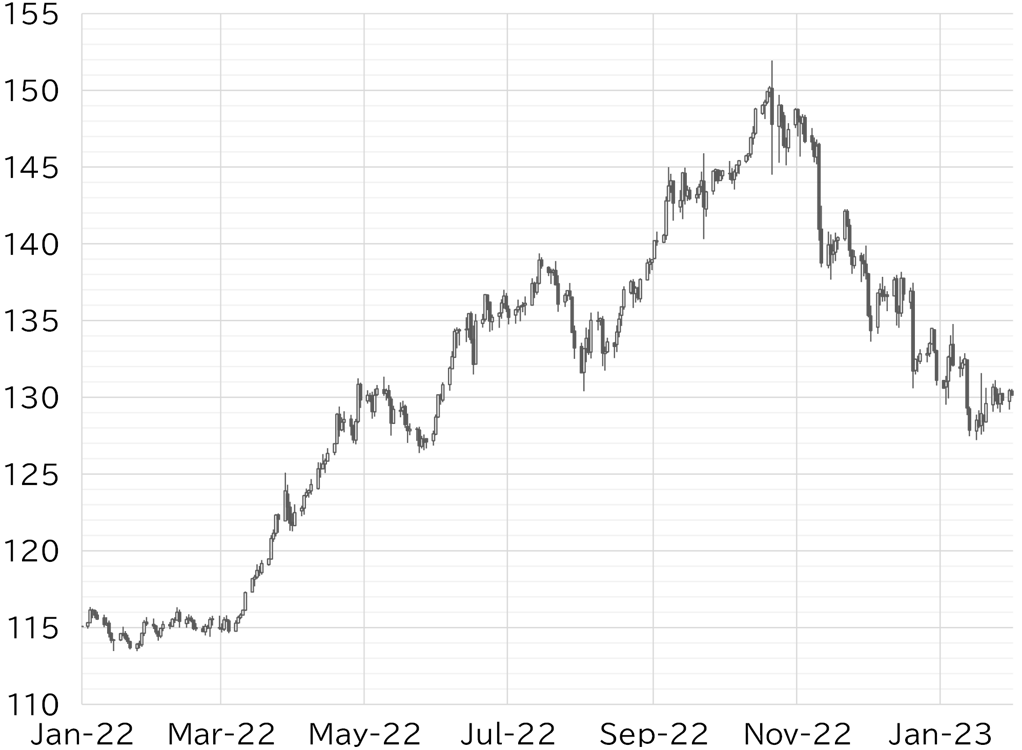
Note: As at 11:00am JST on 31 January
Source: EBS, MUFG
FIGURE 2: MAJOR CURRENCIES' RATE OF CHANGE VS USD IN JANUARY
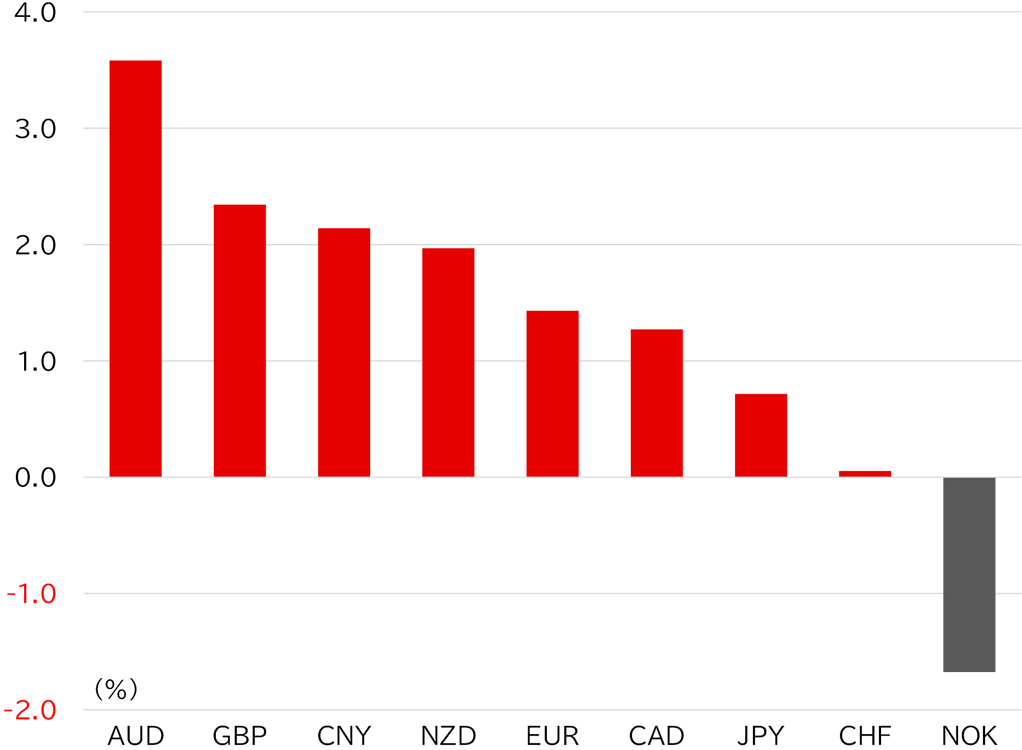
Note: As at 11:00am JST on 31 January
Source: Bloomberg, MUFG
Pace of USD/JPY decline has slowed amid expectations of narrowing monetary policy gap
The USD/JPY rose to around 135 at the beginning of January, regaining ground following the BOJ's surprise on 20 December, but ultimately it hit a new near-term low and at the time of writing this report looks likely to end the month lower than it started. The monthly candlestick looks likely to have a long upper and lower wick. The pace of the USD/JPY's decline has slowed compared to November and December, both of which featured long black candlesticks. In fact, the disparity in monetary policy between Japan and the US which has driven the USD/JPY decline over the last few months, has recently been impacted by a mix of news flow.
First, in the US, economic indicators have continued to miss market expectations. The ISM index in December fell below the watershed 50 level for both manufacturing and non-manufacturing (Figure 3). The YoY declines in leading economic indicators are also growing. The CPI in December confirmed a slowdown in inflation, prompting senior Fed officials to start talking about disinflation. Under these circumstances, it is almost certain that the FOMC meeting statement on 1 February will show a further reduction in the pace of interest rate increases, from 50bp in December to 25bp. Expectations have therefore already been toned down from the start of the year, when the market anticipated that the Fed would likely stick to a 50bp increase. Some data, such as the 4Q GDP report, suggest the US economy is solid, but the market still expects the Fed to take monetary policy in a more dovish direction, which has encouraged the dollar to remain weak.
Second, the BOJ's talk of policy adjustment at the monetary policy meeting in December has increased expectations that the Bank will move to normalize monetary policy, but it appears to be a case of taking three steps forward and two steps back. Reports that the government and the BOJ were considering revising the joint statement became a focus for overseas investors in particular, acting to accelerate yen buying on expectations that the BOJ would end its YCC policy at the January policy meeting. However, the BOJ ended up increasing the flexibility of its funds-supplying operations against pooled collateral in order to support YCC, which seems to have stopped excessive expectations for the normalization of monetary policy. The USD/JPY is also showing firmness. However, we see no indication that yen-selling sentiment will return because the announcement of a new BOJ executive post-Kuroda is just around the corner and inflation in Japan is accelerating (Figure 4).
FIGURE 3: ISM INDEX

Source: Institute for Supply Management, MUFG
FIGURE 4: JAPAN'S CPI GROWTH (YOY)
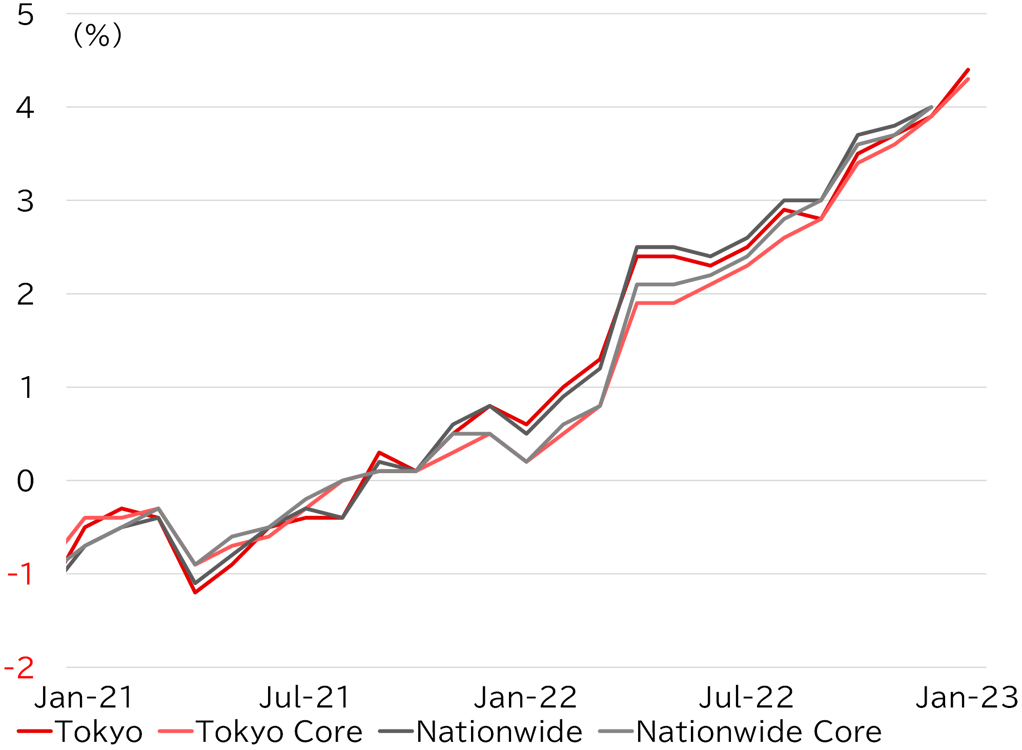
Source: MIC, MUFG
Timing of end to rate hikes and debt ceiling issue
Comments by Fed Vice Chair Lael Brainard and Governor Christopher J. Waller just before the blackout period have made the market all but certain that the FOMC will increase interest rates by 25bp by 1 February. The focus for this meeting will therefore be on whether the Fed gives any clues about plans for the next FOMC meeting in March, or on any indication of the conditions for halting interest rate hikes, which the market expects the Fed to do in the near future. Based on the dot plot announced at the FOMC in December, we had expected a 50bp in February and then a final 25bp at the next meeting in March, which would bring the terminal rate of the FF interest rate to the upper limit of 5.25%. However, the WSJ reported that talks of ending of rate increases this spring would be on the table. In other words, slowing to a 25bp increase in February does not necessarily mean rate increases will continue for longer, but that the Fed could be thinking of reducing the terminal rate (Figure 5). We continue to expect the Fed to halt interest rate hikes in March, meaning it will lower the terminal rate. Based on Chair Jay Powell's communication to date, he is unlikely to signal an end to interest rate hikes in March at the FOMC meeting in February, although he will probably not deny the possibility of that either. We expect such dialogue with the market will temporarily stop the dollar from weakening.
Meanwhile, the prospect of hitting the federal government debt ceiling has recently emerged as an issue (Figure 6). Treasury Secretary Janet Yellen announced on 19 January that the debt limit had been reached. The government has already taken special measures such as suspending contributions from government agencies to civil servants' retirement funds. The special measures and tax revenue will sustain other government spending for the time being, but without raising or suspending the debt limit, the government will soon face the prospect of being unable to make interest payments on USTs or make payments to private companies and may have to suspend civil servant salaries. However, we see little prospect of resolving the crisis at the moment since Congress became divided following the midterm elections in November last year, and although the Democrats hold a majority in the Senate and the Republicans a majority in the House, both parties are having trouble rallying their caucus. Yellen has set a 5 June deadline for the special measures, though it is unclear when government payments that depend on tax revenue will stop. We expect a response will be required within the next six months.
Some argue that if the government is unable to respond to this and has to suspend payments, it will lead to an economic recession and turmoil in the financial markets. The handling of this issue is therefore likely to have a significant impact on future monetary policy decisions. However, given that the US economy is currently deteriorating and debate about whether an economic recession can be avoided, even if such a situation does not come to pass, an environment in which Congress has difficulty deciding how to respond is likely to have an impact, such as destabilizing financial markets. We therefore see the possibility that the FOMC will be in a position where it is unable to tighten monetary policy by the time of the meeting in May.
FIGURE 5: MEDIAN OF FF RATE FORECASTS AT LAST YEAR'S FOMC MEETING
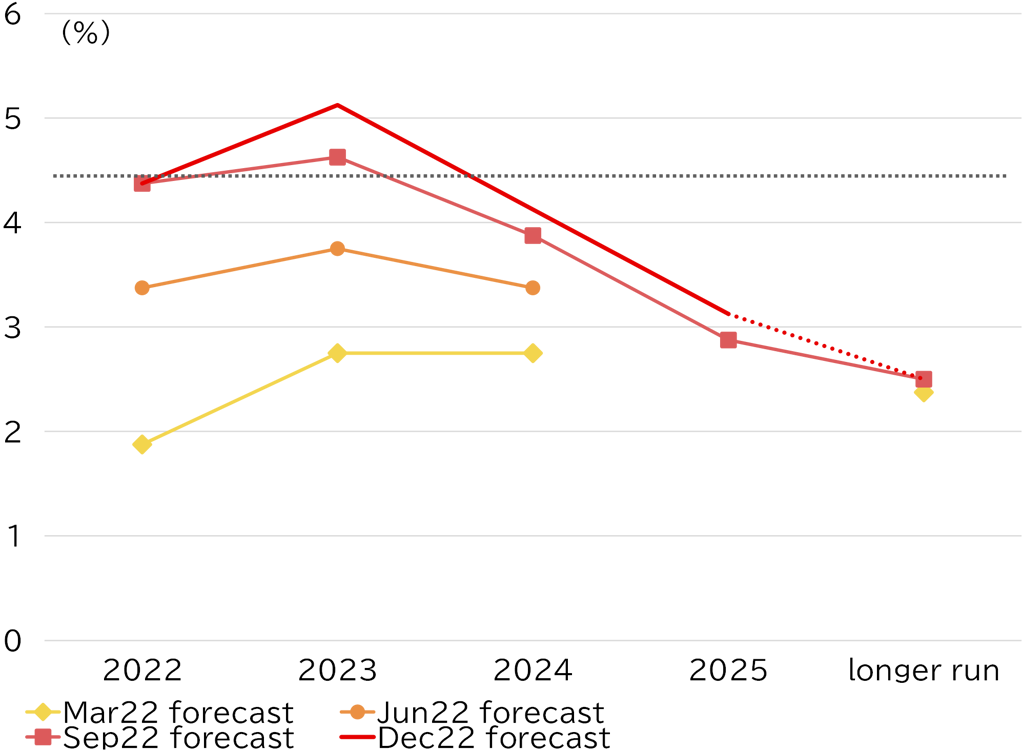
Source: Fed, MUFG
FIGURE 6: US FEDERAL GOVERNMENT'S DEBT BALANCE AND STATUTORY DEBT LIMIT
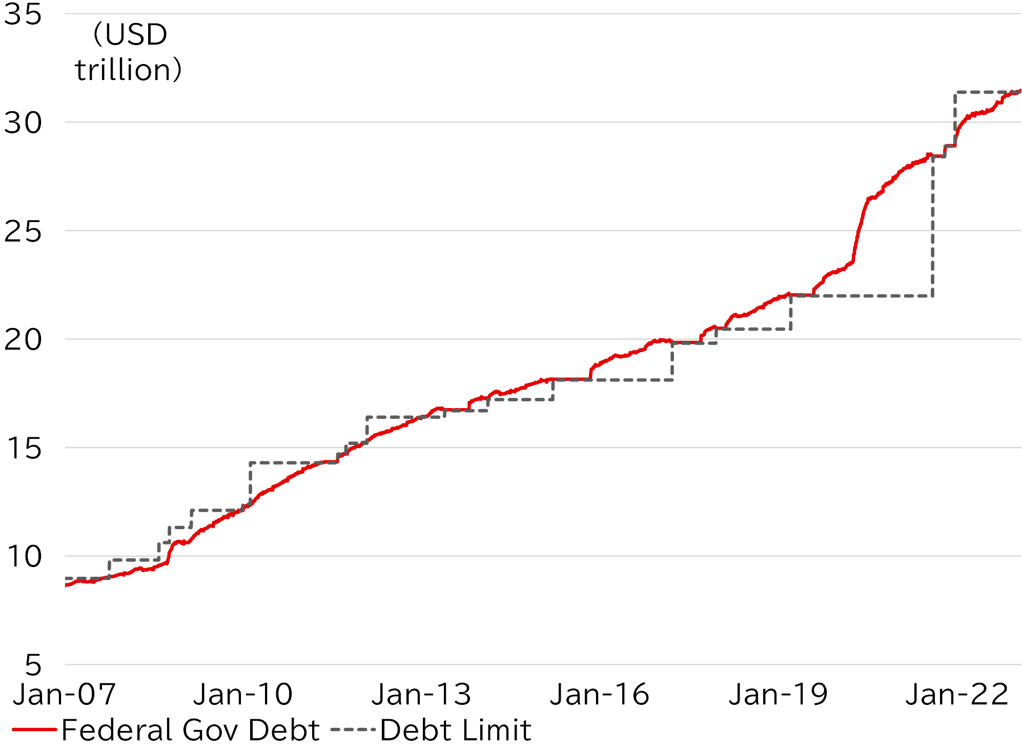
Source: US Treasury, MUFG
BOJ announces new system ahead of monetary policy normalization
Meanwhile, the BOJ at its monetary policy meeting in January did not bow to growing expectations ahead of the meeting that the Bank would end YCC, and in fact ended up introducing more flexibility to its funds-supplying operations against pooled collateral. This is intended to curb JGB yields and swap rate curves by lowering funding costs for banks and increasing the benefit of receiving fixed interest rates on JGB purchases and swap transactions. Amid heightened expectations for the end of YCC, the 10y JGB yield has pushed up against or exceeded the de facto upper limit of 0.50%, and the 10y swap rate, which is out of reach of direct intervention through YCC, rose to nearly 1% (Figure 7). The previous policy adjustment in December was explained as an attempt to restore the functioning of the (bond) market in order to increase the sustainability of YCC, but it seems it quickly became necessary for the Bank to take additional measures. However, the Bank's decision to maintain YCC flew in the face of what mainly overseas speculators were aiming for, leaving them disappointed.
It should be noted that the increased flexibility in funds-supplying operations against pooled collateral is not something that can be sustained for the long term because there is a limit to the amount of collateral that banks can park at the BOJ. In addition, the funds procured from this operation are expected to be used to purchase JGBs, but with the end of the YCC in sight, banks and other investors will probably be hesitant about buying more JGBs than necessary. This move can therefore be viewed as a life-prolonging measure as long as YCC continues. In fact, although the policy has had some impact on pushing down the yield curve as a whole, the intended distortion of the JGB yield curve has not been eliminated, as Governor Kuroda noted at the Q&A session before the Diet on 30 January (Figure 8).
Nominees for the BOJ executive are finally expected to be presented to the Diet. This is expected to include the candidates for governor as well as for the two deputy-governors whose terms will expire earlier in March. Reuters has reported that the announcement will be made on 10 February, but the names could be revealed before then considering that procedures such as a statement of opinion in both houses of the Diet are necessary. Based on precedent since the new law came into effect, the next governor is most likely to be from the BOJ, and the media has speculated that candidates could include Deputy Governor Masayoshi Amamiya, former Deputy Governor Hiroshi Nakaso, and former Deputy Governor Hirohide Yamaguchi. Yuri Okina, also from the BOJ, is rumored to be among candidates to become the next deputy governor. Attention is focused on who will be the next governor but looking at how Kuroda was elected with the first arrow of Abenomics, who decides will be more important this time as well. It could also be someone whose name has not been mentioned.
At his New Year's press conference on 4 January, Prime Minister Fumio Kishida, who will basically have the final word on who is appointed, declared that the government would finally put an end to the long-standing problems facing the Japanese economy and activate the foundation for a new virtuous cycle, noting that over the past 30 years wages have not grown as much as expected despite a rise in corporate earnings, and that no trickle-down effect had been apparent. The comments come on the year that marks the 10th anniversary of Abenomics, which had aimed to recover Japan's 'lost' 20 years over the subsequent 10 years. We surmise that these remarks are rooted in an underlying belief that, regardless of the direction, the way that monetary policy has been conducted needs to change. In that regard, the urgent proposal announced on 30 January by Reiwa Rincho, where deputy governor candidate Yuri Okina serves as the managing secretary, could serve as a starting point for the stance of the new system if Okina is appointed to the BOJ executive. The Reiwa Rincho proposed a review of the joint statement, including setting the 2% price stability target that the BOJ is currently adhering to as a long-term target. In addition, it indicated the need move toward restoring the function of interest rates and the normalization of the JGB market within a certain time horizon. Although it avoided mentioning specific measures for normalization, it noted that the government should aim to return to a world with interest rates while establishing safety nets and stability measures. Extraordinary easing measures call for correspondingly extraordinary exit strategies. This means it may sometimes be necessary to take unusual steps such as making funds-supplying operations against pooled collateral more flexible. It is reasonable to assume that the plan is to overcome the difficult situation by appointing a governor well versed in monetary policy. This means the choice of who to appoint as governor may be straight-forward, even while being aware of a change in monetary policy.
In any case, the gears toward the normalization of monetary policy have already begun to turn. The market has already factored in an end to YCC and easing measures such as the implementation of funds-supplying operations against pooled collateral are preventing the yen from strengthening. However, considering that the USD/JPY fell by about 1 yen due to headlines made by Reiwa Rincho, the announcement of the new executive alone could depress the USD/JPY further, and the yen may continue to strengthen if any specific actions become clear.
FIGURE 7: YIELD CURVE ON 17 JANUARY (DAY BEFORE THE MEETING DECISION)
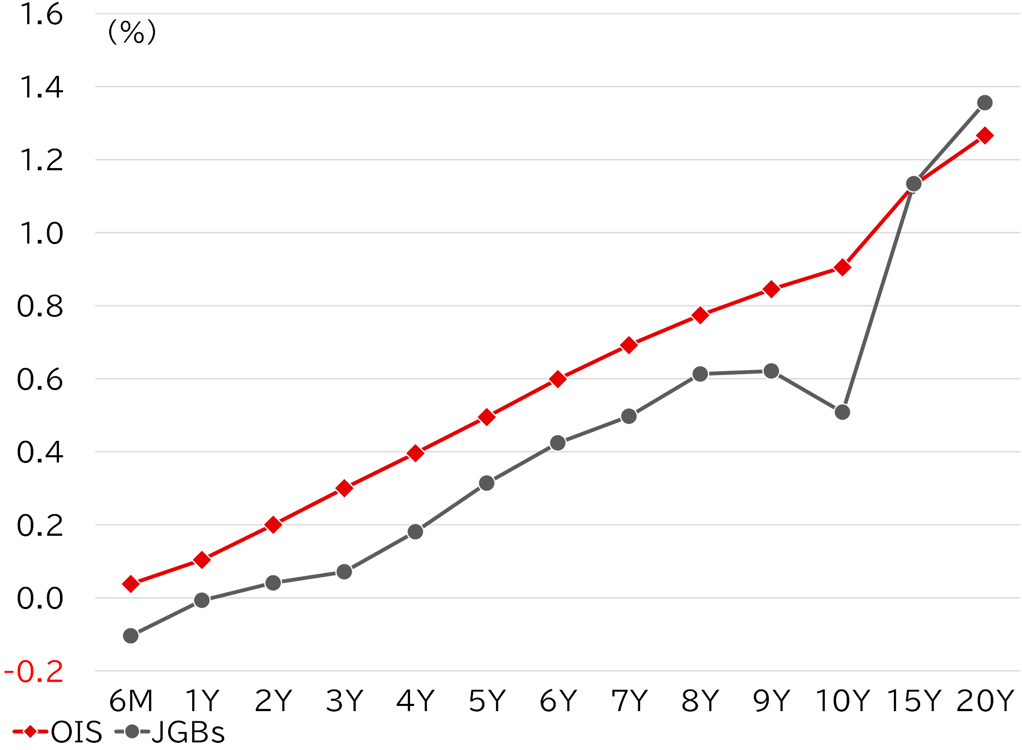
Source: Bloomberg, MUFG
FIGURE 8: YIELD CURVE ON 31 JANUARY (DAY THIS REPORT WAS WRITTEN)
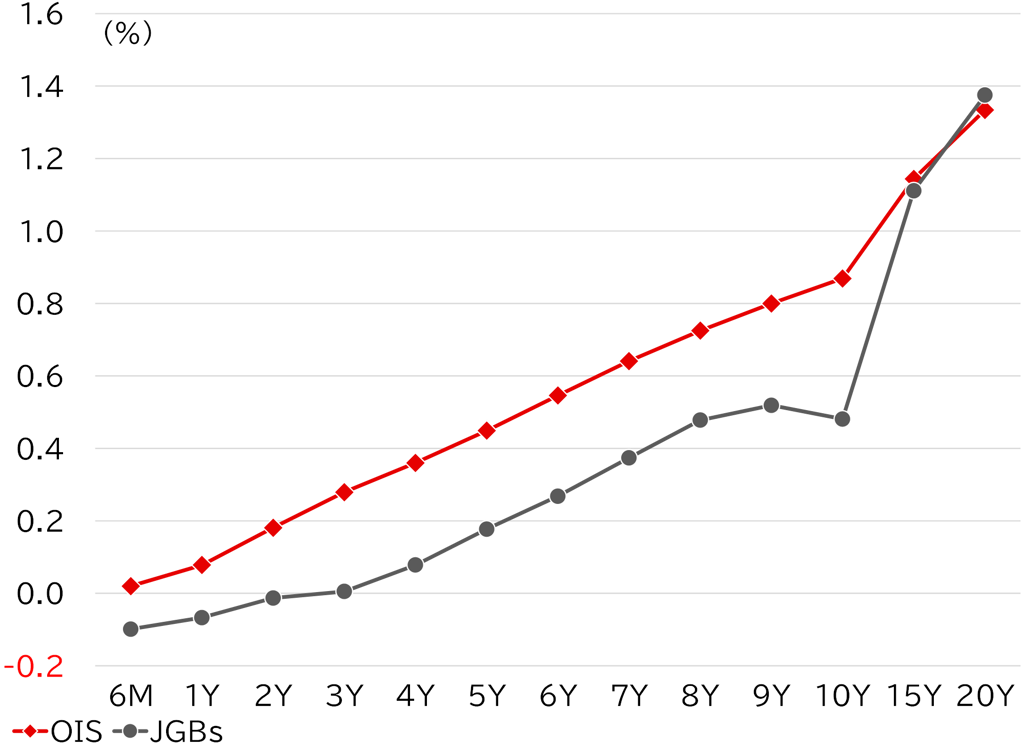
Source: Bloomberg, MUFG
Risk of USD/JPY reversal declines; revising forecast range
We had expected the BOJ to begin normalizing monetary policy after the appointment of a new governor in April, but we brought forward this timeline following the Bank's monetary policy meeting in December. We shifted our forecast range for the USD/JPY to reflect a stronger yen. We had expected the FOMC to gradually reduce the pace of rate increases with a 50bp hike in February and a 25bp hike in March but anticipated that Chair Powell and other Fed officials would maintain a hawkish stance in dialogue with the market, and as a result, we expected the USD/JPY to return to around 140. However, leading US economic indicators and other data in January continued to show signs of an economic slowdown, and comments from regional Fed presidents and high-ranking officials including Fed Vice Chair Lael Brainard and Fed Governor Christopher Waller suggested that the FOMC would slow the pace of rate increases to 25bp in February. We expect the US economy will start to slow in earnest and that hitting the federal debt limit will put downside pressure on the economy. The risk of turmoil in the financial markets has also reduced the scope for the dollar to strengthen and the USD/JPY to pull higher in the near term. We have therefore revised our forecast range for the USD/JPY.
QUARTERLY FORECAST RANGE AND PERIOD-END FORECAST
|
Feb-Mar 2023 |
Apr-Jun |
Jul-Sep |
Oct-Dec |
|
|
USD/JPY |
124.0~136.0 |
122.0~134.0 |
120.0~132.0 |
118.0~130.0 |
|
Period-end forecast |
130.0 |
127.0 |
125.0 |
123.0 |
Our forecast range estimates the high and low for each quarter. The period-end forecast is our forecast for USD/JPY at 17:00 New York time at the end of each quarter.



